JCU NS3363 Mental Health Nursing Assignment: Substance Abuse Report
VerifiedAdded on 2022/11/13
|9
|2345
|148
Report
AI Summary
This nursing assignment delves into the critical aspects of substance abuse assessment, drawing insights from a case study of a patient named Terry. The report emphasizes the significance of a comprehensive assessment using tools like the TAPS tool to identify the extent of substance abuse and its impact on mental health. It explores essential aspects of the assessment process, including gathering patient history, understanding predisposing factors, and addressing suicidal ideation. The assignment further highlights the importance of therapeutic relationships, self-reflection, and the role of mental health nurses in providing supportive care. It also identifies government and non-government services available to assist patients with substance use disorders. The report underscores the need for empathetic and culturally sensitive care, emphasizing the importance of active listening, communication techniques, and a non-judgmental approach to foster a therapeutic environment. The assignment also touches upon the importance of risk assessment and problem-solving skills in effective patient care. The references include a list of relevant sources used to support the arguments.
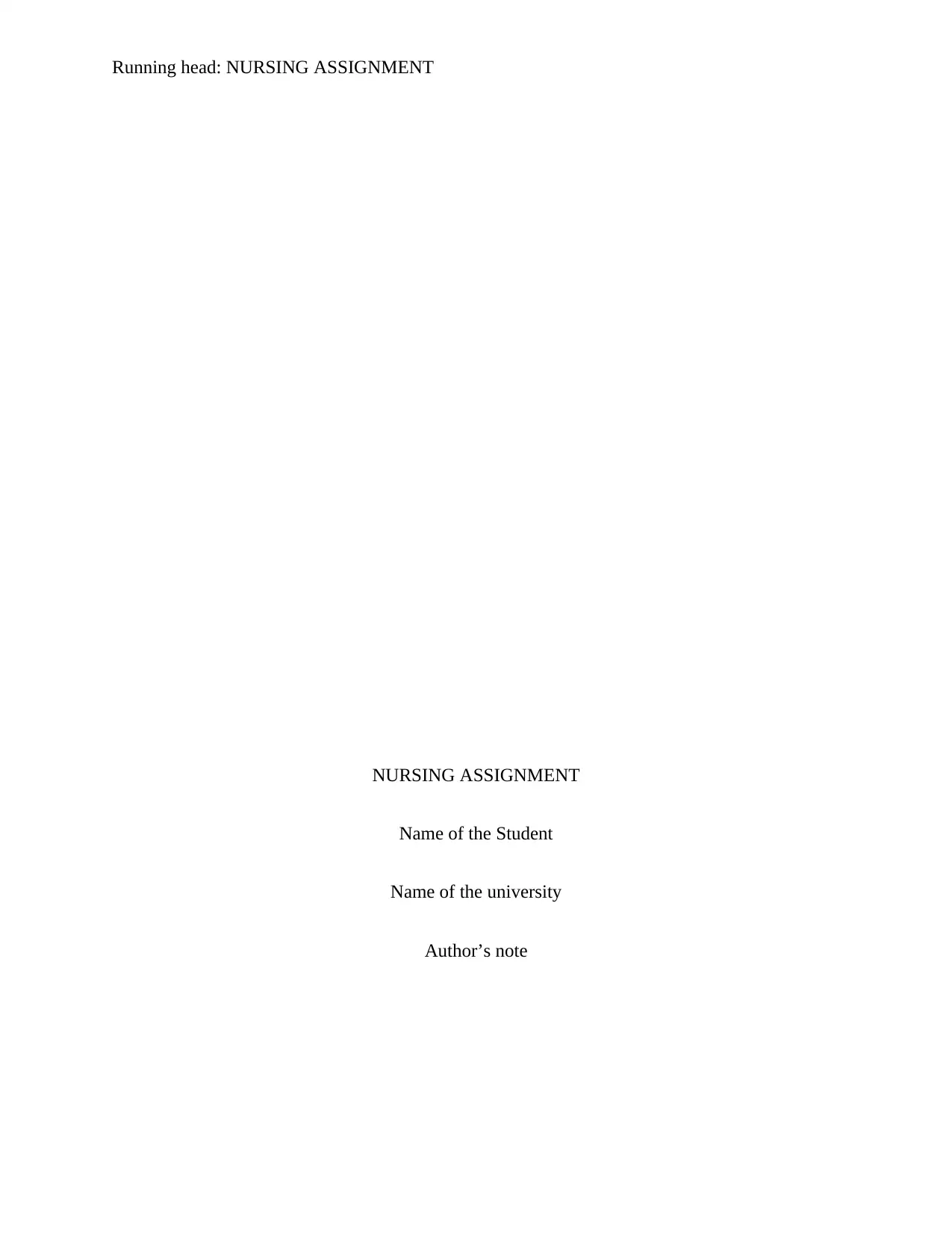
Running head: NURSING ASSIGNMENT
NURSING ASSIGNMENT
Name of the Student
Name of the university
Author’s note
NURSING ASSIGNMENT
Name of the Student
Name of the university
Author’s note
Paraphrase This Document
Need a fresh take? Get an instant paraphrase of this document with our AI Paraphraser
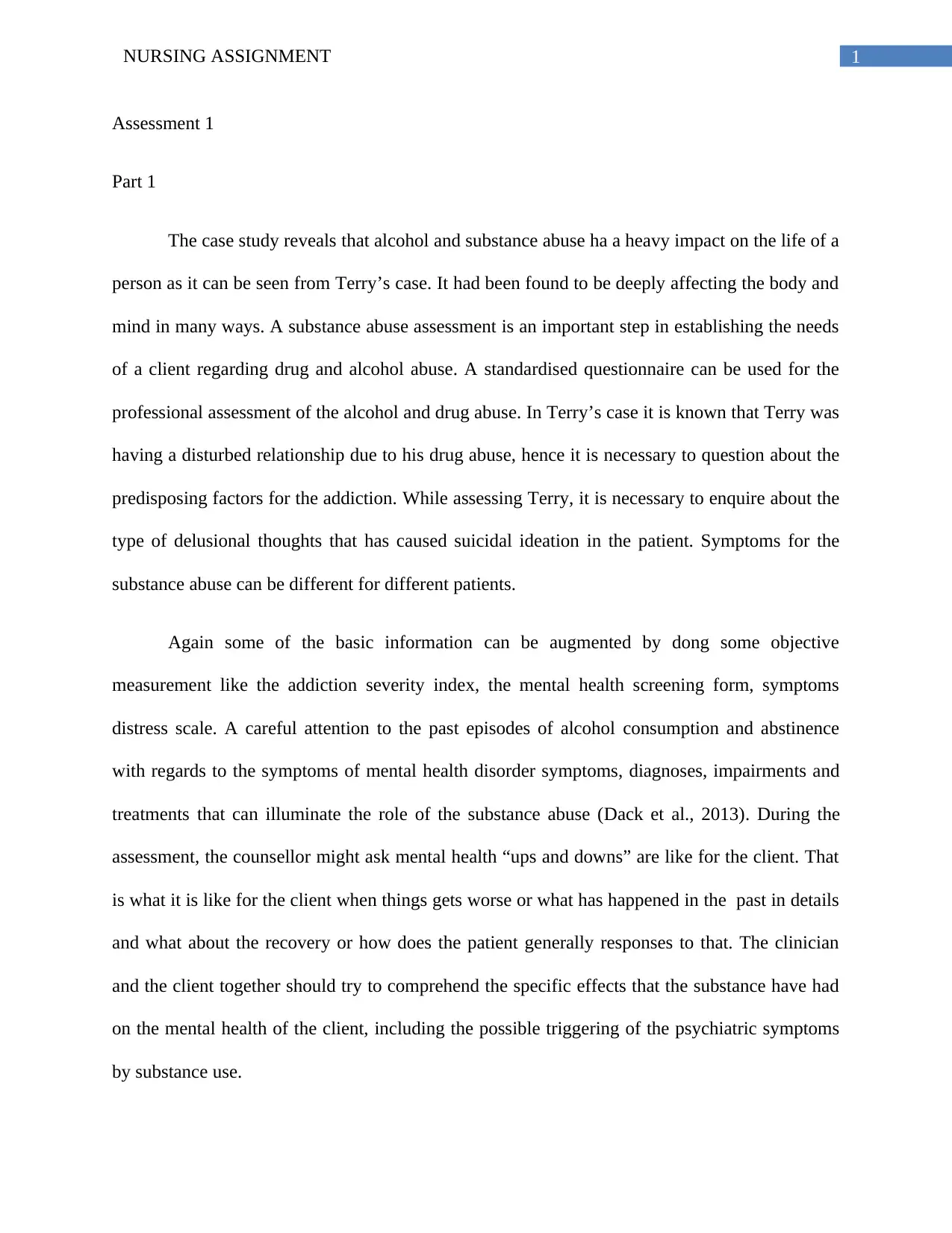
1NURSING ASSIGNMENT
Assessment 1
Part 1
The case study reveals that alcohol and substance abuse ha a heavy impact on the life of a
person as it can be seen from Terry’s case. It had been found to be deeply affecting the body and
mind in many ways. A substance abuse assessment is an important step in establishing the needs
of a client regarding drug and alcohol abuse. A standardised questionnaire can be used for the
professional assessment of the alcohol and drug abuse. In Terry’s case it is known that Terry was
having a disturbed relationship due to his drug abuse, hence it is necessary to question about the
predisposing factors for the addiction. While assessing Terry, it is necessary to enquire about the
type of delusional thoughts that has caused suicidal ideation in the patient. Symptoms for the
substance abuse can be different for different patients.
Again some of the basic information can be augmented by dong some objective
measurement like the addiction severity index, the mental health screening form, symptoms
distress scale. A careful attention to the past episodes of alcohol consumption and abstinence
with regards to the symptoms of mental health disorder symptoms, diagnoses, impairments and
treatments that can illuminate the role of the substance abuse (Dack et al., 2013). During the
assessment, the counsellor might ask mental health “ups and downs” are like for the client. That
is what it is like for the client when things gets worse or what has happened in the past in details
and what about the recovery or how does the patient generally responses to that. The clinician
and the client together should try to comprehend the specific effects that the substance have had
on the mental health of the client, including the possible triggering of the psychiatric symptoms
by substance use.
Assessment 1
Part 1
The case study reveals that alcohol and substance abuse ha a heavy impact on the life of a
person as it can be seen from Terry’s case. It had been found to be deeply affecting the body and
mind in many ways. A substance abuse assessment is an important step in establishing the needs
of a client regarding drug and alcohol abuse. A standardised questionnaire can be used for the
professional assessment of the alcohol and drug abuse. In Terry’s case it is known that Terry was
having a disturbed relationship due to his drug abuse, hence it is necessary to question about the
predisposing factors for the addiction. While assessing Terry, it is necessary to enquire about the
type of delusional thoughts that has caused suicidal ideation in the patient. Symptoms for the
substance abuse can be different for different patients.
Again some of the basic information can be augmented by dong some objective
measurement like the addiction severity index, the mental health screening form, symptoms
distress scale. A careful attention to the past episodes of alcohol consumption and abstinence
with regards to the symptoms of mental health disorder symptoms, diagnoses, impairments and
treatments that can illuminate the role of the substance abuse (Dack et al., 2013). During the
assessment, the counsellor might ask mental health “ups and downs” are like for the client. That
is what it is like for the client when things gets worse or what has happened in the past in details
and what about the recovery or how does the patient generally responses to that. The clinician
and the client together should try to comprehend the specific effects that the substance have had
on the mental health of the client, including the possible triggering of the psychiatric symptoms
by substance use.

2NURSING ASSIGNMENT
Assessment tool needed to ascertain further information
The Tobacco, Alcohol, Prescription medication, and other Substance use (TAPS) Tool is
a useful tool that contains a combined screening component (TAPS-1), followed by a brief
assessment (TAPS-2) for those patients who screen positive (McNeely et al, 2016). The tool is
useful for the screening and the brief assessment of the commonly used substance, eliminating
the requirement for multiple screening and lengthy assessment tools. The tool provide a two
stage brief assessment (McNeely et al., 2016). The tool can either be self-administered by the
patients or can be taken as an interview by health care professionals. The tool is normally used in
an electronic format. The presence of a screening component helps to know about the frequency
of the substance abuse in the past years. The tool would also be proven to be useful as it will
facilitate a brief assessment of past 90 day problem use to the client.
Further information about the significant events in Terry’s history pertinent to his
substance abuse
The initial step in the assessment process is to engage the patient in an empathetic and
welcoming manner and built a rapport for facilitating an open disclosure of information
regarding the metal health problems, substance use disorder. Some of the questions that should
be asked to Terry to inform about the treatment outcomes are- the age of first drink or use, about
his drinking partners, information about his peers, triggers that increases the chance of drinking,
family, trauma history, financial situation, housing status, education, strengths resources and the
employments, family history of alcoholism, substance abuse or substance use disorder (Muskett,
2014). It is again necessary to screen for any family history of the mental health problems
including the diagnosis, hospitalisation and other forms of treatment, the current symptoms, the
Assessment tool needed to ascertain further information
The Tobacco, Alcohol, Prescription medication, and other Substance use (TAPS) Tool is
a useful tool that contains a combined screening component (TAPS-1), followed by a brief
assessment (TAPS-2) for those patients who screen positive (McNeely et al, 2016). The tool is
useful for the screening and the brief assessment of the commonly used substance, eliminating
the requirement for multiple screening and lengthy assessment tools. The tool provide a two
stage brief assessment (McNeely et al., 2016). The tool can either be self-administered by the
patients or can be taken as an interview by health care professionals. The tool is normally used in
an electronic format. The presence of a screening component helps to know about the frequency
of the substance abuse in the past years. The tool would also be proven to be useful as it will
facilitate a brief assessment of past 90 day problem use to the client.
Further information about the significant events in Terry’s history pertinent to his
substance abuse
The initial step in the assessment process is to engage the patient in an empathetic and
welcoming manner and built a rapport for facilitating an open disclosure of information
regarding the metal health problems, substance use disorder. Some of the questions that should
be asked to Terry to inform about the treatment outcomes are- the age of first drink or use, about
his drinking partners, information about his peers, triggers that increases the chance of drinking,
family, trauma history, financial situation, housing status, education, strengths resources and the
employments, family history of alcoholism, substance abuse or substance use disorder (Muskett,
2014). It is again necessary to screen for any family history of the mental health problems
including the diagnosis, hospitalisation and other forms of treatment, the current symptoms, the
⊘ This is a preview!⊘
Do you want full access?
Subscribe today to unlock all pages.

Trusted by 1+ million students worldwide

3NURSING ASSIGNMENT
mental health status medication and adherence to medications. It is again necessary to screen for
and detect the co-occurring disorders.
It is necessary to understand the triggering factors behind the suicidal ideation of Terry,
his relationship with his girlfriend. It is again necessary to understand about his peer
relationships as peer pressure is often an important case of a substance abuse disorder. An
important component of a person centered assessment is the continuous recognition that the
culture of the patient plays a significant role in the determination of the viewpoint of the client in
the treatment (Arnow et al., 2016). At the time of the assessment procedure it is necessary to
ascertain the sexual orientation of an individual. A clinician should be able to consider the
possibility of the trauma history before the starting of the assessment. Trauma might include
early childhood physical, emotional or sexual abuse (Muskett, 2014).
Part 2
Some of the government and the non-government services available in the local area
which could assist Terry in addressing his substance abuse disorder are – Head space, Ozcare
drug and alcohol residential recovery service, Lives lived well.
Lives lived well
This is an organization that provides support to the people living in Queensland and the
communities of New South Wales who are the victims of alcohol and drugs. The main
philosophy of the organization is that they adopt a holistic, empathetic and harm minimizing
approach to bring back these people back to the normal pace of life. This organization provides
free alcohol and drug counselor for the people of Queensland. Special attention is given to young
people, aboriginal and the Torres Strait Islanders’ communities and those with complex care
mental health status medication and adherence to medications. It is again necessary to screen for
and detect the co-occurring disorders.
It is necessary to understand the triggering factors behind the suicidal ideation of Terry,
his relationship with his girlfriend. It is again necessary to understand about his peer
relationships as peer pressure is often an important case of a substance abuse disorder. An
important component of a person centered assessment is the continuous recognition that the
culture of the patient plays a significant role in the determination of the viewpoint of the client in
the treatment (Arnow et al., 2016). At the time of the assessment procedure it is necessary to
ascertain the sexual orientation of an individual. A clinician should be able to consider the
possibility of the trauma history before the starting of the assessment. Trauma might include
early childhood physical, emotional or sexual abuse (Muskett, 2014).
Part 2
Some of the government and the non-government services available in the local area
which could assist Terry in addressing his substance abuse disorder are – Head space, Ozcare
drug and alcohol residential recovery service, Lives lived well.
Lives lived well
This is an organization that provides support to the people living in Queensland and the
communities of New South Wales who are the victims of alcohol and drugs. The main
philosophy of the organization is that they adopt a holistic, empathetic and harm minimizing
approach to bring back these people back to the normal pace of life. This organization provides
free alcohol and drug counselor for the people of Queensland. Special attention is given to young
people, aboriginal and the Torres Strait Islanders’ communities and those with complex care
Paraphrase This Document
Need a fresh take? Get an instant paraphrase of this document with our AI Paraphraser
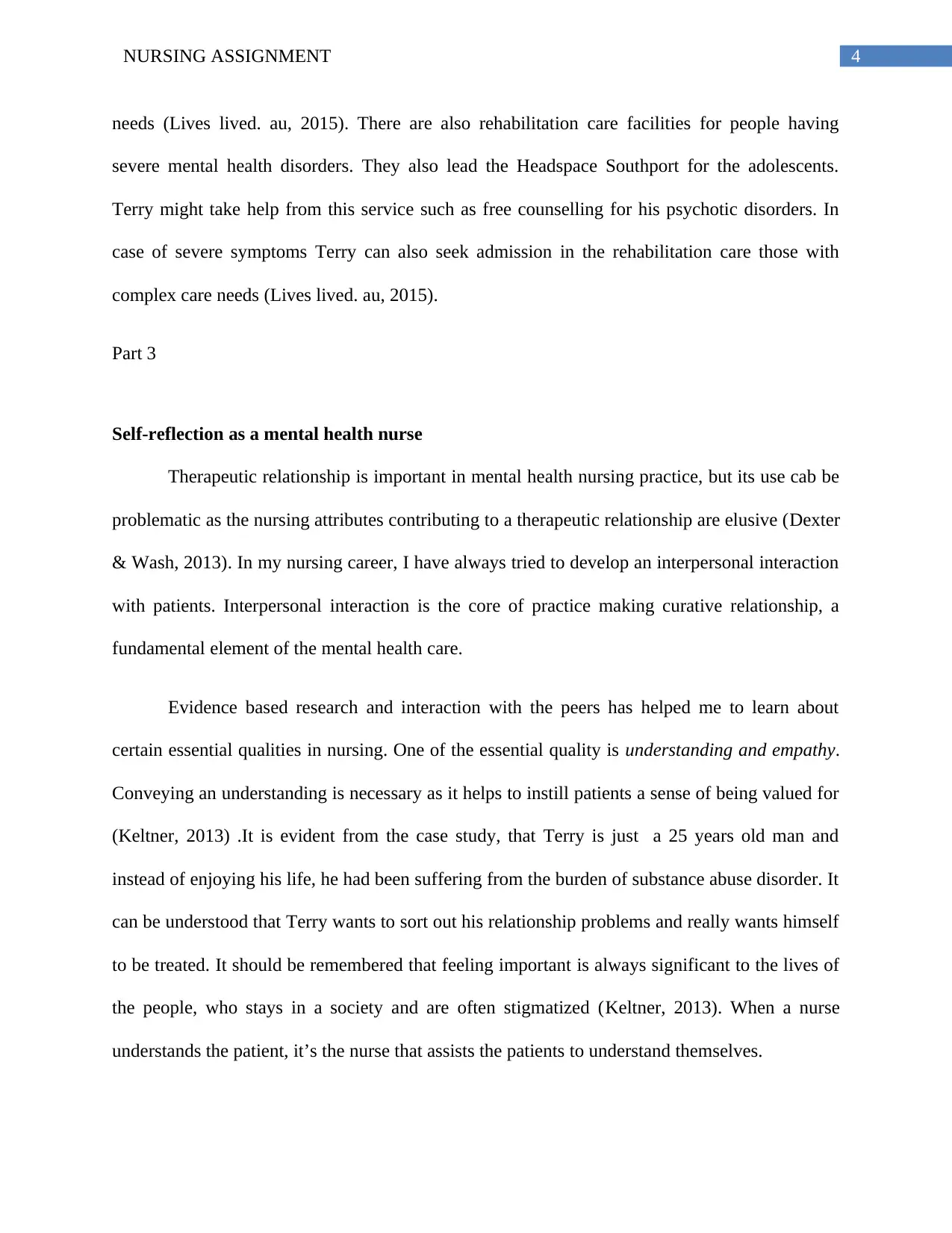
4NURSING ASSIGNMENT
needs (Lives lived. au, 2015). There are also rehabilitation care facilities for people having
severe mental health disorders. They also lead the Headspace Southport for the adolescents.
Terry might take help from this service such as free counselling for his psychotic disorders. In
case of severe symptoms Terry can also seek admission in the rehabilitation care those with
complex care needs (Lives lived. au, 2015).
Part 3
Self-reflection as a mental health nurse
Therapeutic relationship is important in mental health nursing practice, but its use cab be
problematic as the nursing attributes contributing to a therapeutic relationship are elusive (Dexter
& Wash, 2013). In my nursing career, I have always tried to develop an interpersonal interaction
with patients. Interpersonal interaction is the core of practice making curative relationship, a
fundamental element of the mental health care.
Evidence based research and interaction with the peers has helped me to learn about
certain essential qualities in nursing. One of the essential quality is understanding and empathy.
Conveying an understanding is necessary as it helps to instill patients a sense of being valued for
(Keltner, 2013) .It is evident from the case study, that Terry is just a 25 years old man and
instead of enjoying his life, he had been suffering from the burden of substance abuse disorder. It
can be understood that Terry wants to sort out his relationship problems and really wants himself
to be treated. It should be remembered that feeling important is always significant to the lives of
the people, who stays in a society and are often stigmatized (Keltner, 2013). When a nurse
understands the patient, it’s the nurse that assists the patients to understand themselves.
needs (Lives lived. au, 2015). There are also rehabilitation care facilities for people having
severe mental health disorders. They also lead the Headspace Southport for the adolescents.
Terry might take help from this service such as free counselling for his psychotic disorders. In
case of severe symptoms Terry can also seek admission in the rehabilitation care those with
complex care needs (Lives lived. au, 2015).
Part 3
Self-reflection as a mental health nurse
Therapeutic relationship is important in mental health nursing practice, but its use cab be
problematic as the nursing attributes contributing to a therapeutic relationship are elusive (Dexter
& Wash, 2013). In my nursing career, I have always tried to develop an interpersonal interaction
with patients. Interpersonal interaction is the core of practice making curative relationship, a
fundamental element of the mental health care.
Evidence based research and interaction with the peers has helped me to learn about
certain essential qualities in nursing. One of the essential quality is understanding and empathy.
Conveying an understanding is necessary as it helps to instill patients a sense of being valued for
(Keltner, 2013) .It is evident from the case study, that Terry is just a 25 years old man and
instead of enjoying his life, he had been suffering from the burden of substance abuse disorder. It
can be understood that Terry wants to sort out his relationship problems and really wants himself
to be treated. It should be remembered that feeling important is always significant to the lives of
the people, who stays in a society and are often stigmatized (Keltner, 2013). When a nurse
understands the patient, it’s the nurse that assists the patients to understand themselves.
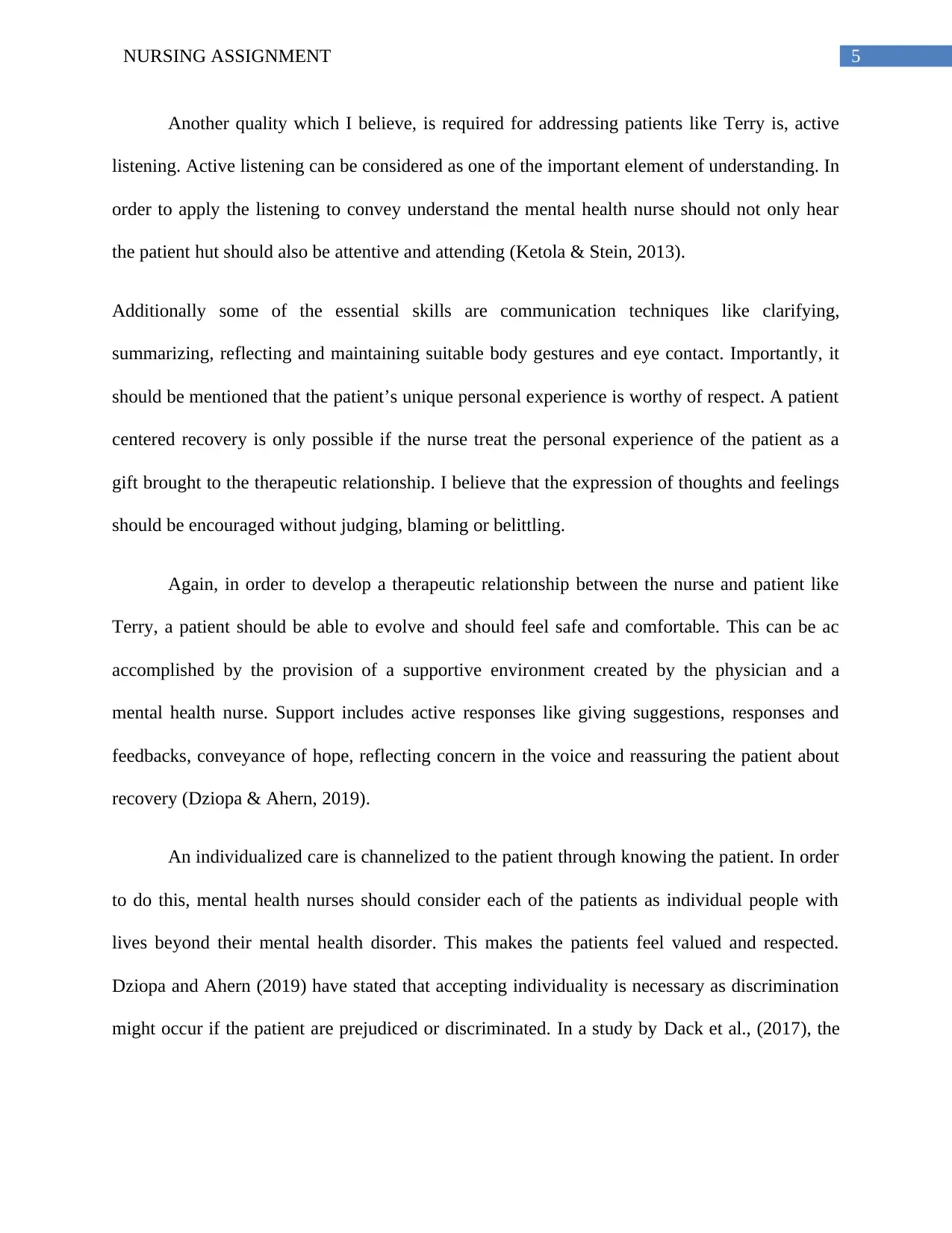
5NURSING ASSIGNMENT
Another quality which I believe, is required for addressing patients like Terry is, active
listening. Active listening can be considered as one of the important element of understanding. In
order to apply the listening to convey understand the mental health nurse should not only hear
the patient hut should also be attentive and attending (Ketola & Stein, 2013).
Additionally some of the essential skills are communication techniques like clarifying,
summarizing, reflecting and maintaining suitable body gestures and eye contact. Importantly, it
should be mentioned that the patient’s unique personal experience is worthy of respect. A patient
centered recovery is only possible if the nurse treat the personal experience of the patient as a
gift brought to the therapeutic relationship. I believe that the expression of thoughts and feelings
should be encouraged without judging, blaming or belittling.
Again, in order to develop a therapeutic relationship between the nurse and patient like
Terry, a patient should be able to evolve and should feel safe and comfortable. This can be ac
accomplished by the provision of a supportive environment created by the physician and a
mental health nurse. Support includes active responses like giving suggestions, responses and
feedbacks, conveyance of hope, reflecting concern in the voice and reassuring the patient about
recovery (Dziopa & Ahern, 2019).
An individualized care is channelized to the patient through knowing the patient. In order
to do this, mental health nurses should consider each of the patients as individual people with
lives beyond their mental health disorder. This makes the patients feel valued and respected.
Dziopa and Ahern (2019) have stated that accepting individuality is necessary as discrimination
might occur if the patient are prejudiced or discriminated. In a study by Dack et al., (2017), the
Another quality which I believe, is required for addressing patients like Terry is, active
listening. Active listening can be considered as one of the important element of understanding. In
order to apply the listening to convey understand the mental health nurse should not only hear
the patient hut should also be attentive and attending (Ketola & Stein, 2013).
Additionally some of the essential skills are communication techniques like clarifying,
summarizing, reflecting and maintaining suitable body gestures and eye contact. Importantly, it
should be mentioned that the patient’s unique personal experience is worthy of respect. A patient
centered recovery is only possible if the nurse treat the personal experience of the patient as a
gift brought to the therapeutic relationship. I believe that the expression of thoughts and feelings
should be encouraged without judging, blaming or belittling.
Again, in order to develop a therapeutic relationship between the nurse and patient like
Terry, a patient should be able to evolve and should feel safe and comfortable. This can be ac
accomplished by the provision of a supportive environment created by the physician and a
mental health nurse. Support includes active responses like giving suggestions, responses and
feedbacks, conveyance of hope, reflecting concern in the voice and reassuring the patient about
recovery (Dziopa & Ahern, 2019).
An individualized care is channelized to the patient through knowing the patient. In order
to do this, mental health nurses should consider each of the patients as individual people with
lives beyond their mental health disorder. This makes the patients feel valued and respected.
Dziopa and Ahern (2019) have stated that accepting individuality is necessary as discrimination
might occur if the patient are prejudiced or discriminated. In a study by Dack et al., (2017), the
⊘ This is a preview!⊘
Do you want full access?
Subscribe today to unlock all pages.

Trusted by 1+ million students worldwide
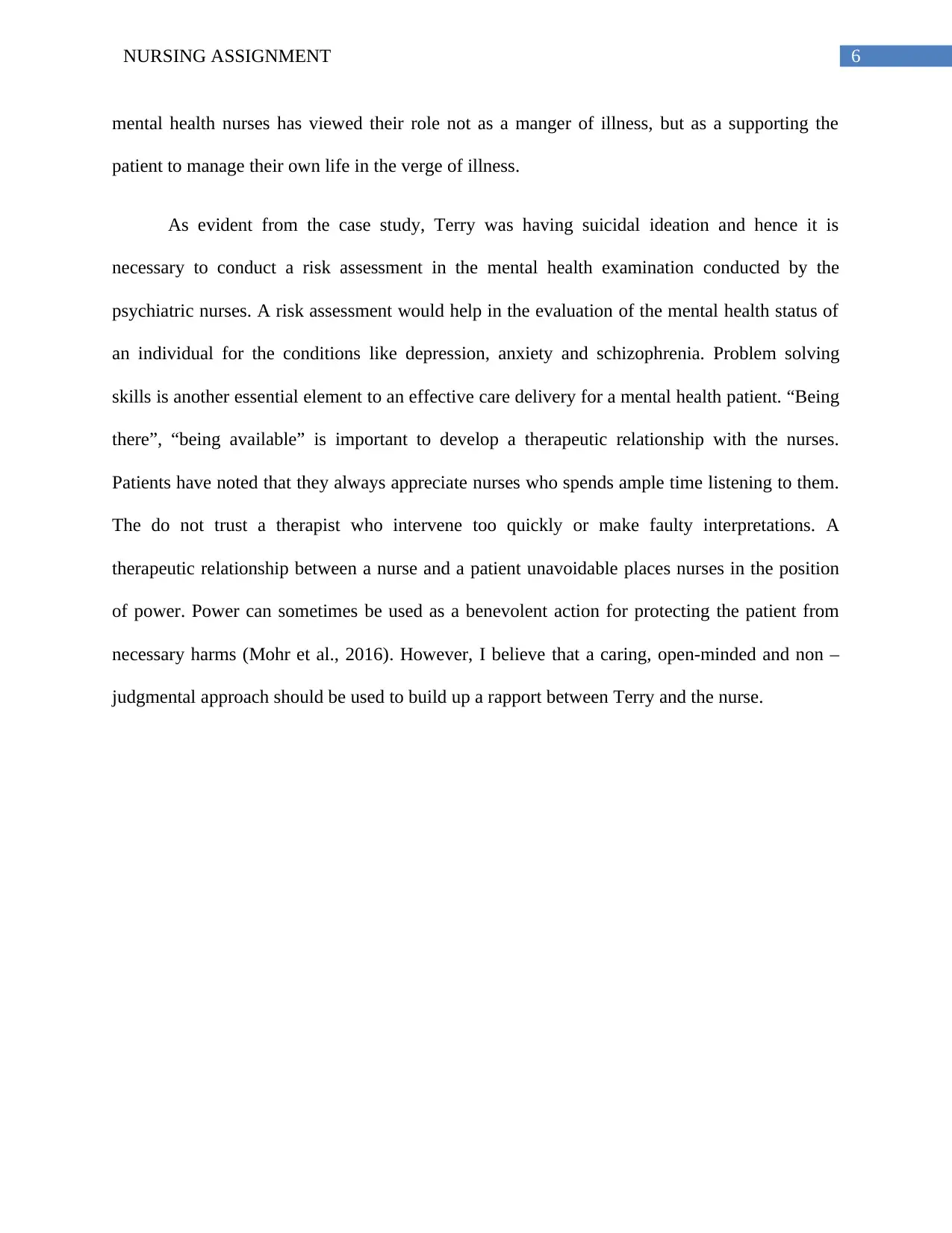
6NURSING ASSIGNMENT
mental health nurses has viewed their role not as a manger of illness, but as a supporting the
patient to manage their own life in the verge of illness.
As evident from the case study, Terry was having suicidal ideation and hence it is
necessary to conduct a risk assessment in the mental health examination conducted by the
psychiatric nurses. A risk assessment would help in the evaluation of the mental health status of
an individual for the conditions like depression, anxiety and schizophrenia. Problem solving
skills is another essential element to an effective care delivery for a mental health patient. “Being
there”, “being available” is important to develop a therapeutic relationship with the nurses.
Patients have noted that they always appreciate nurses who spends ample time listening to them.
The do not trust a therapist who intervene too quickly or make faulty interpretations. A
therapeutic relationship between a nurse and a patient unavoidable places nurses in the position
of power. Power can sometimes be used as a benevolent action for protecting the patient from
necessary harms (Mohr et al., 2016). However, I believe that a caring, open-minded and non –
judgmental approach should be used to build up a rapport between Terry and the nurse.
mental health nurses has viewed their role not as a manger of illness, but as a supporting the
patient to manage their own life in the verge of illness.
As evident from the case study, Terry was having suicidal ideation and hence it is
necessary to conduct a risk assessment in the mental health examination conducted by the
psychiatric nurses. A risk assessment would help in the evaluation of the mental health status of
an individual for the conditions like depression, anxiety and schizophrenia. Problem solving
skills is another essential element to an effective care delivery for a mental health patient. “Being
there”, “being available” is important to develop a therapeutic relationship with the nurses.
Patients have noted that they always appreciate nurses who spends ample time listening to them.
The do not trust a therapist who intervene too quickly or make faulty interpretations. A
therapeutic relationship between a nurse and a patient unavoidable places nurses in the position
of power. Power can sometimes be used as a benevolent action for protecting the patient from
necessary harms (Mohr et al., 2016). However, I believe that a caring, open-minded and non –
judgmental approach should be used to build up a rapport between Terry and the nurse.
Paraphrase This Document
Need a fresh take? Get an instant paraphrase of this document with our AI Paraphraser

7NURSING ASSIGNMENT
References
Arnow, B. A., Steidtmann, D., Blasey, C., Manber, R., Constantino, M. J., Klein, D. N., ... &
Kocsis, J. H. (2013). The relationship between the therapeutic alliance and treatment
outcome in two distinct psychotherapies for chronic depression. Journal of consulting and
clinical psychology, 81(4), 627.
Dack, C., Ross, J., Papadopoulos, C., Stewart, D., & Bowers, L. (2013). A review and meta‐
analysis of the patient factors associated with psychiatric in‐patient aggression. Acta
Psychiatrica Scandinavica, 127(4), 255-268.
Dexter, G., & Wash, M. (2013). Psychiatric nursing skills: A patient-centred approach. Springer.
Dziopa, F., & Ahern, K. J. (2019). What makes a quality therapeutic relationship in
psychiatric/mental health nursing: A review of the research literature. Internet Journal of
Advanced Nursing Practice, 10(1), 7-7.
Jansen, R., & Venter, I. (2015). Psychiatric nursing: An unpopular choice. Journal of psychiatric
and mental health nursing, 22(2), 142-148.
Keltner, N. L. (2013). Psychiatric nursing. Elsevier Health Sciences.
Ketola, J., & Stein, J. V. (2013). Psychiatric clinical course strengthens the student–patient
relationships of baccalaureate nursing students. Journal of Psychiatric and Mental Health
Nursing, 20(1), 23-34.
References
Arnow, B. A., Steidtmann, D., Blasey, C., Manber, R., Constantino, M. J., Klein, D. N., ... &
Kocsis, J. H. (2013). The relationship between the therapeutic alliance and treatment
outcome in two distinct psychotherapies for chronic depression. Journal of consulting and
clinical psychology, 81(4), 627.
Dack, C., Ross, J., Papadopoulos, C., Stewart, D., & Bowers, L. (2013). A review and meta‐
analysis of the patient factors associated with psychiatric in‐patient aggression. Acta
Psychiatrica Scandinavica, 127(4), 255-268.
Dexter, G., & Wash, M. (2013). Psychiatric nursing skills: A patient-centred approach. Springer.
Dziopa, F., & Ahern, K. J. (2019). What makes a quality therapeutic relationship in
psychiatric/mental health nursing: A review of the research literature. Internet Journal of
Advanced Nursing Practice, 10(1), 7-7.
Jansen, R., & Venter, I. (2015). Psychiatric nursing: An unpopular choice. Journal of psychiatric
and mental health nursing, 22(2), 142-148.
Keltner, N. L. (2013). Psychiatric nursing. Elsevier Health Sciences.
Ketola, J., & Stein, J. V. (2013). Psychiatric clinical course strengthens the student–patient
relationships of baccalaureate nursing students. Journal of Psychiatric and Mental Health
Nursing, 20(1), 23-34.
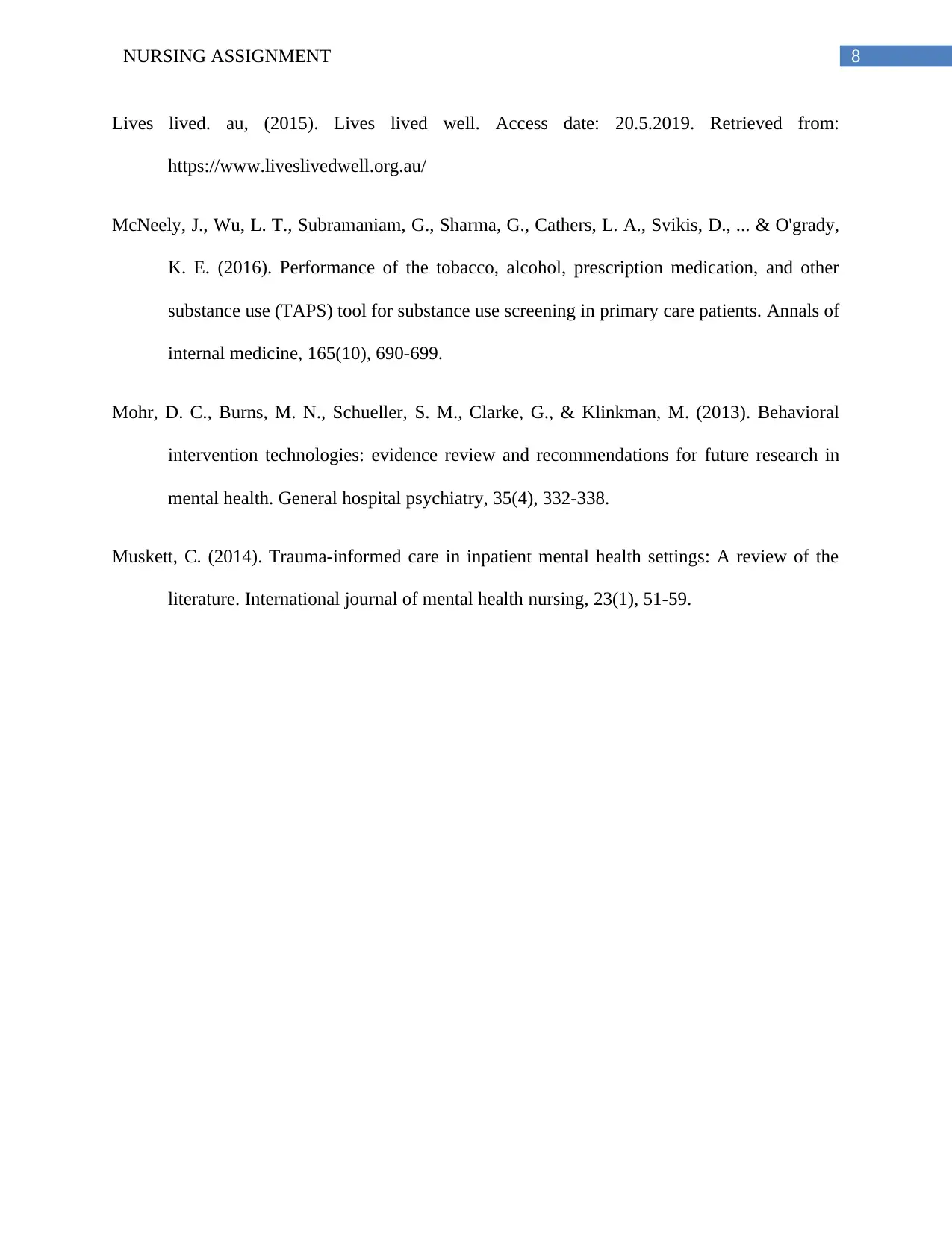
8NURSING ASSIGNMENT
Lives lived. au, (2015). Lives lived well. Access date: 20.5.2019. Retrieved from:
https://www.liveslivedwell.org.au/
McNeely, J., Wu, L. T., Subramaniam, G., Sharma, G., Cathers, L. A., Svikis, D., ... & O'grady,
K. E. (2016). Performance of the tobacco, alcohol, prescription medication, and other
substance use (TAPS) tool for substance use screening in primary care patients. Annals of
internal medicine, 165(10), 690-699.
Mohr, D. C., Burns, M. N., Schueller, S. M., Clarke, G., & Klinkman, M. (2013). Behavioral
intervention technologies: evidence review and recommendations for future research in
mental health. General hospital psychiatry, 35(4), 332-338.
Muskett, C. (2014). Trauma‐informed care in inpatient mental health settings: A review of the
literature. International journal of mental health nursing, 23(1), 51-59.
Lives lived. au, (2015). Lives lived well. Access date: 20.5.2019. Retrieved from:
https://www.liveslivedwell.org.au/
McNeely, J., Wu, L. T., Subramaniam, G., Sharma, G., Cathers, L. A., Svikis, D., ... & O'grady,
K. E. (2016). Performance of the tobacco, alcohol, prescription medication, and other
substance use (TAPS) tool for substance use screening in primary care patients. Annals of
internal medicine, 165(10), 690-699.
Mohr, D. C., Burns, M. N., Schueller, S. M., Clarke, G., & Klinkman, M. (2013). Behavioral
intervention technologies: evidence review and recommendations for future research in
mental health. General hospital psychiatry, 35(4), 332-338.
Muskett, C. (2014). Trauma‐informed care in inpatient mental health settings: A review of the
literature. International journal of mental health nursing, 23(1), 51-59.
⊘ This is a preview!⊘
Do you want full access?
Subscribe today to unlock all pages.

Trusted by 1+ million students worldwide
1 out of 9
Related Documents
Your All-in-One AI-Powered Toolkit for Academic Success.
+13062052269
info@desklib.com
Available 24*7 on WhatsApp / Email
![[object Object]](/_next/static/media/star-bottom.7253800d.svg)
Unlock your academic potential
Copyright © 2020–2025 A2Z Services. All Rights Reserved. Developed and managed by ZUCOL.





